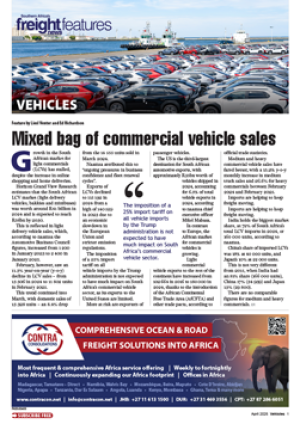AFTER MORE than a year of protracted and detailed discussion among all interested parties, the Local Advisory Committee (LAC) set up to finalise a report on the container terminal solution in Durban, has made its decision.
Of major import is the outright rejection of the proposed Pier No 3 on the central sandbank. This will no doubt satisfy all the environmental interests.
The remainder of the LAC recommendations deal with a short-term Ôfix and one long-term plan, with upgrading of extensions to 108, 109 and 205 on Pier 2 being completed as speedily as possible, and the immediate implementation of a programme to improve the efficiency of all current container handling operations. This will allow another 220 000 teus p.a. to be handled. Work here is already in progress.
Slightly more far-reaching recommendations propose that the area presently occupied by the ship-repair industry at Bayhead be given over to a new container terminal, but this would first require an environmental impact assessment (EIA). This would provide a further 400 000 teu slots within a time frame of 19 months. This proposal has run into immediate opposition from the shipbuilding industry, whose spokesmen speak out against any suggestion of them having to move.
The LAC goes on to suggest that Maydon Wharf 9, 10 and 11 (the corner area at the end of the wharf) be converted to a full container handling facility, subject to successful negotiation with relevant lease-holders as well as business, shipping and labour interests. To page 16 From page 1 This would provide another 300 000 teu slots, with minimal time required except for quay wall extensions. An EIA will also have to be conducted.
Finally, and more far-reaching in its scope, the LAC says that a study for the southwards expansion of the harbour should be implemented as soon as possible. If this study shows that none of the southward expansion options are viable, then the option of a new container facility between Pier 1 and Salisbury Island should be revisited. The southward expansion plan is the only way in which Durban can expand in terms of the size and capability, and requires more innovative and visionary thinking on the part of the authorities than has been evident so far. The cost would be high, but the benefit of being able to increase container handling by another 1,6 million teus would take Durban well into the next century as a major world container handling port. Among the problems presented is that Spoornet already occupies this area with the Bayhead marshalling yard, which would have to be relocated.
This set of recommendations, which is what the IEM Process has been working towards for more than a year, will now be presented to the Transnet Board for their decision, before finally going to the Minister of Public Enterprises and the cabinet. The LAC has announced it will advertise these recommendations as a means of ensuring that as many interested people as possible are made fully aware of what has transpired.
We haven't heard the last word on this lengthy process. Members representing business and shipping interests on the LAC are reported to be unhappy. They say the LAC reached a decision by consensus and they now intend to draft a letter to Portnet and express their concerns through the Harbour Users' task force. What these concerns are hasn't been revealed.
